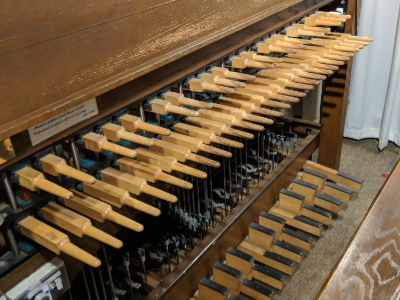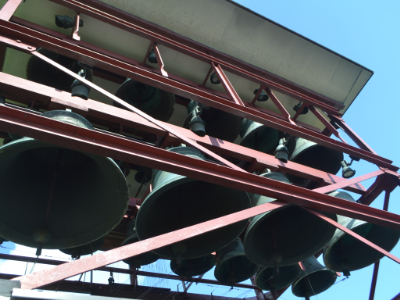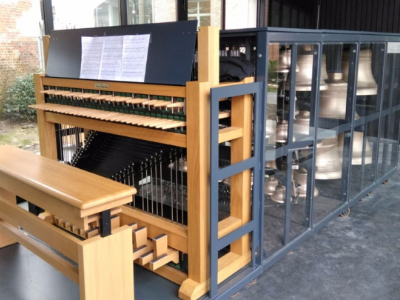What is a carillon?
A carillon is a musical instrument composed of at least 23 carillon bells, arranged in chromatic sequence, so tuned as to produce concordant harmony when many bells are sounded together.
Carillon bells are typically made of bronze and can range in weight from only a few pounds to over ten tons. The Riverside Church in New York City has the heaviest carillon in the world, weighing over 100 tons, while some of the lightest carillons may only weigh about 3 tons. Regardless of their weight, all carillons are played in the same way: at a keyboard with one's hands and feet.
As shown in the above images, carillons can be installed in many types of towers. In many carillons, the bells reside in an enclosed bell chamber that allows the sound to mix and blend before escaping through the tower's louvres. In other carillons, the "bell chamber" might be in open air with no walls for the sound to bounce off of. Each kind of configuration can impact how a carillon sounds to the listener on the ground.
Instrument Range
Although carillons can have as few as 23 bells, most carillons have many more than this, with the "standard" being around 48 bells. Below you can see the standard ranges for different types of carillons. It is important to note that many standard and smaller carillons lack a low C-sharp and sometimes also the D-sharp because of how expensive bass bells are given the amount of bronze it takes to cast them. If you want to ensure that your arrangement will be playable on the most instruments, you might wish to suggest an alternative option for the carillon player if you include these notes in your writing.
Small Carillons2 to 3.5 octaves

Standard Carillons4 to 4.5 octaves

Grand Carillons4.5+ octaves

Repertoire
Carillonneurs today have access to a diverse and ever-growing repertoire of music. Before the twentieth century, this repertoire consisted almost entirely of improvisations and arrangements of already existing music, but today, new compositions are frequently composed specifically for the carillon and form a very significant portion of the instrument’s repertoire. Even with so many original compositions available now to carillonneurs, arrangements are anything but lost from the repertoire. Rather, carillon concerts and weekly playings today normally consist of a balance between original compositions and arrangements.
Arrangements in particular are a valuable and necessary way for carillonneurs to connect with the diverse communities that make up their audience. Consequently, being able to make carillon arrangements, and to do this effectively and efficiently, can be a crucial asset to any carillonneur!









